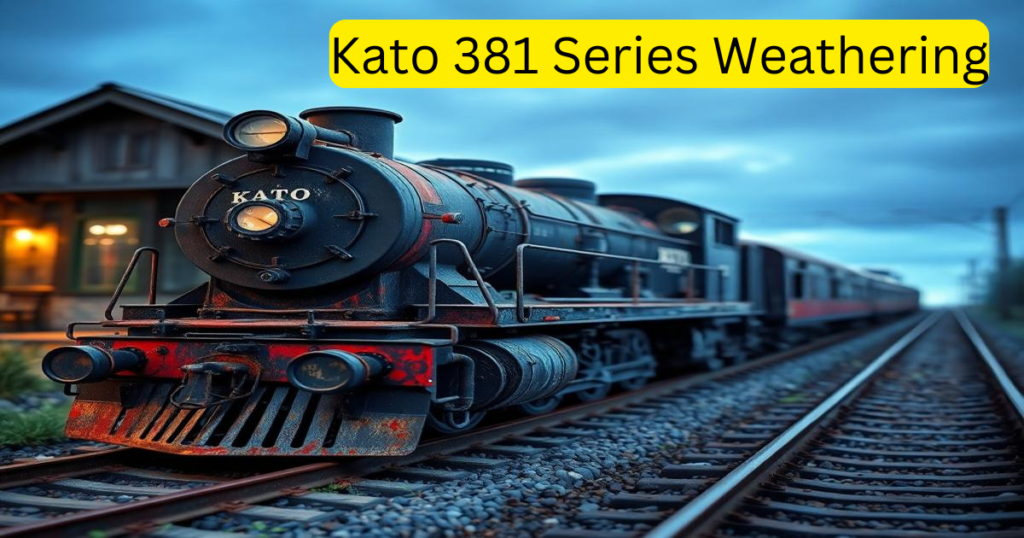Weathering is an art form in model railroading that can transform a standard locomotive into a lifelike representation of its real-world counterparts. If you’re a fan of the Kato 381 Series Weathering, you’re in for a treat. This article will guide you through the process of weathering these delightful models, enhancing their realism and showcasing your skills as a modeler.
Introduction
Have you ever looked at a model train and felt that something was missing? Perhaps it felt too pristine, too ‘out of the box’ perfect? Kato 381 Series Weathering can bridge that gap, giving your Kato 381 series a character that speaks of journeys, age, and authenticity. In this article, we’ll delve into various techniques, materials, and tips to help you weather your Kato 381 series like a pro.
Understanding Weathering
What is Weathering?
Weathering mimics the effects of time and the elements on a model. This can include dirt accumulation, rust spots, faded paint, and marks from usage. To truly capture the essence of a real locomotive, understanding weathering techniques, such as those applied to the Kato 381 Series Weathering, is critical.
Why Weather Kato 381 Models?
The Kato 381 series is known for its stunning detail and craftsmanship, but these traits can be enhanced through weathering:
- Realism: A weathered model reflects the stories and history behind the train.
- Personalization: Shows your creativity and unique style.
- Skill Development: Weathering can help improve your modeling skills.
Weathering Techniques
Washes and Filters
One of the most accessible ways to begin weathering your Kato 381 models is through washes and filters.
What You Need:
- Acrylic Paints: Water-soluble paints are ideal for washes.
- Thinner: Use water or a specialized thinner.
Technique:
- Prepare your paint: Mix acrylic paint with a lot of water (about 70% water to 30% paint) to create a wash.
- Apply: Using a brush, apply the wash to areas like the undercarriage, wheel wells, and crevices.
- Wipe: After a few moments, lightly wipe away excess to leave color in recesses to create depth.
Dry Brushing
Dry brushing is a technique that adds highlights to raised surfaces, simulating wear and tear.
Steps to Follow:
- Choose a lighter color: Select a shade that is lighter than the base color of the model.
- Prepare your brush: Dip your brush into the paint, then wipe off most of it on a paper towel.
- Apply lightly: Gently brush over raised details, like rivets and panel lines, to bring them to life.
Pigments
Pigments are powders that enhance the texture of your weathering, such as for the Kato 381 Series Weathering. They can add dirt, soot, rust, or even dust effects.
How to Use Pigments:
- Select your colors: Choose appropriate shades (e.g., black for soot, brown for dirt).
- Mix with a medium: Combine pigments with a medium to create a paste.
- Apply: Use a brush or your fingers to apply the mixture to desired areas. You can even use a stiff brush to create a more blown-out dust effect.
Common Areas to Weather on the Kato 381 Series
Undercarriage and Chassis
The undercarriage often collects grime and dirt first. Focus on:
- Wheel Faces: Use pigments to simulate dirt accumulated from use.
- Bolsters and Trucks: Apply details for a worn-out look, suggesting many trips across rail.
Roof and Body
The roof is a high-visibility area prone to weathering:
- Dirt Accumulation: Add washes to mimic rain streaks and dirt.
- Rust Patches: Use pigmented rust tones on metallic areas.
Tips for Successful Weathering
- Test on Scrap: Always practice your techniques on scrap plastic or old models.
- Layering is Key: Build up your weathering gradually, allowing each layer to dry before applying the next.
- Reference Real Models: Look at photographs of real trains for inspiration and guidance.
Conclusion
Weathering your Kato 381 Series Weathering locomotives transforms them into unique pieces of art, each telling their own story of time and travel. Whether you choose washes, dry brushing, or pigments, the final result will showcase your dedication and creativity in model railroading. So grab your tools, find some reference images, and get started on your weathering journey today!
“Weathering is not merely a technique; it’s a storytelling craft that breathes life into static models.”
Whether you’re just starting out or looking to refine your skills, the art of weathering offers a rewarding avenue for expression and realism in your modeling endeavors.
